Jin Ma
Coupling Experts and Routers in Mixture-of-Experts via an Auxiliary Loss
Dec 29, 2025Abstract:Mixture-of-Experts (MoE) models lack explicit constraints to ensure the router's decisions align well with the experts' capabilities, which ultimately limits model performance. To address this, we propose expert-router coupling (ERC) loss, a lightweight auxiliary loss that tightly couples the router's decisions with expert capabilities. Our approach treats each expert's router embedding as a proxy token for the tokens assigned to that expert, and feeds perturbed router embeddings through the experts to obtain internal activations. The ERC loss enforces two constraints on these activations: (1) Each expert must exhibit higher activation for its own proxy token than for the proxy tokens of any other expert. (2) Each proxy token must elicit stronger activation from its corresponding expert than from any other expert. These constraints jointly ensure that each router embedding faithfully represents its corresponding expert's capability, while each expert specializes in processing the tokens actually routed to it. The ERC loss is computationally efficient, operating only on n^2 activations, where n is the number of experts. This represents a fixed cost independent of batch size, unlike prior coupling methods that scale with the number of tokens (often millions per batch). Through pre-training MoE-LLMs ranging from 3B to 15B parameters and extensive analysis on trillions of tokens, we demonstrate the effectiveness of the ERC loss. Moreover, the ERC loss offers flexible control and quantitative tracking of expert specialization levels during training, providing valuable insights into MoEs.
Virtual Width Networks
Nov 17, 2025



Abstract:We introduce Virtual Width Networks (VWN), a framework that delivers the benefits of wider representations without incurring the quadratic cost of increasing the hidden size. VWN decouples representational width from backbone width, expanding the embedding space while keeping backbone compute nearly constant. In our large-scale experiment, an 8-times expansion accelerates optimization by over 2 times for next-token and 3 times for next-2-token prediction. The advantage amplifies over training as both the loss gap grows and the convergence-speedup ratio increases, showing that VWN is not only token-efficient but also increasingly effective with scale. Moreover, we identify an approximately log-linear scaling relation between virtual width and loss reduction, offering an initial empirical basis and motivation for exploring virtual-width scaling as a new dimension of large-model efficiency.
DisPatch: Disarming Adversarial Patches in Object Detection with Diffusion Models
Sep 04, 2025
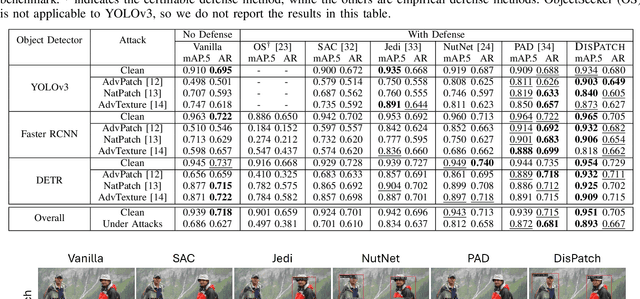
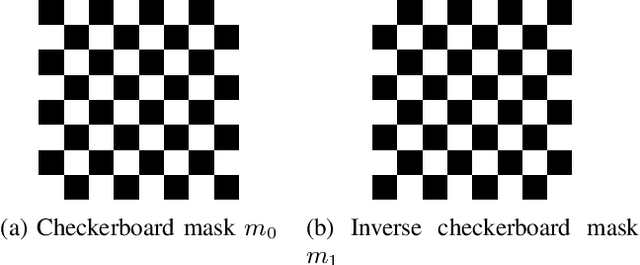

Abstract:Object detection is fundamental to various real-world applications, such as security monitoring and surveillance video analysis. Despite their advancements, state-of-theart object detectors are still vulnerable to adversarial patch attacks, which can be easily applied to real-world objects to either conceal actual items or create non-existent ones, leading to severe consequences. Given the current diversity of adversarial patch attacks and potential unknown threats, an ideal defense method should be effective, generalizable, and robust against adaptive attacks. In this work, we introduce DISPATCH, the first diffusion-based defense framework for object detection. Unlike previous works that aim to "detect and remove" adversarial patches, DISPATCH adopts a "regenerate and rectify" strategy, leveraging generative models to disarm attack effects while preserving the integrity of the input image. Specifically, we utilize the in-distribution generative power of diffusion models to regenerate the entire image, aligning it with benign data. A rectification process is then employed to identify and replace adversarial regions with their regenerated benign counterparts. DISPATCH is attack-agnostic and requires no prior knowledge of the existing patches. Extensive experiments across multiple detectors and attacks demonstrate that DISPATCH consistently outperforms state-of-the-art defenses on both hiding attacks and creating attacks, achieving the best overall mAP.5 score of 89.3% on hiding attacks, and lowering the attack success rate to 24.8% on untargeted creating attacks. Moreover, it maintains strong robustness against adaptive attacks, making it a practical and reliable defense for object detection systems.
ARC-Hunyuan-Video-7B: Structured Video Comprehension of Real-World Shorts
Jul 28, 2025Abstract:Real-world user-generated short videos, especially those distributed on platforms such as WeChat Channel and TikTok, dominate the mobile internet. However, current large multimodal models lack essential temporally-structured, detailed, and in-depth video comprehension capabilities, which are the cornerstone of effective video search and recommendation, as well as emerging video applications. Understanding real-world shorts is actually challenging due to their complex visual elements, high information density in both visuals and audio, and fast pacing that focuses on emotional expression and viewpoint delivery. This requires advanced reasoning to effectively integrate multimodal information, including visual, audio, and text. In this work, we introduce ARC-Hunyuan-Video, a multimodal model that processes visual, audio, and textual signals from raw video inputs end-to-end for structured comprehension. The model is capable of multi-granularity timestamped video captioning and summarization, open-ended video question answering, temporal video grounding, and video reasoning. Leveraging high-quality data from an automated annotation pipeline, our compact 7B-parameter model is trained through a comprehensive regimen: pre-training, instruction fine-tuning, cold start, reinforcement learning (RL) post-training, and final instruction fine-tuning. Quantitative evaluations on our introduced benchmark ShortVid-Bench and qualitative comparisons demonstrate its strong performance in real-world video comprehension, and it supports zero-shot or fine-tuning with a few samples for diverse downstream applications. The real-world production deployment of our model has yielded tangible and measurable improvements in user engagement and satisfaction, a success supported by its remarkable efficiency, with stress tests indicating an inference time of just 10 seconds for a one-minute video on H20 GPU.
Scaling Law for Quantization-Aware Training
May 20, 2025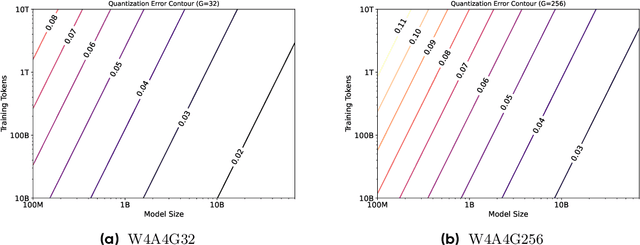
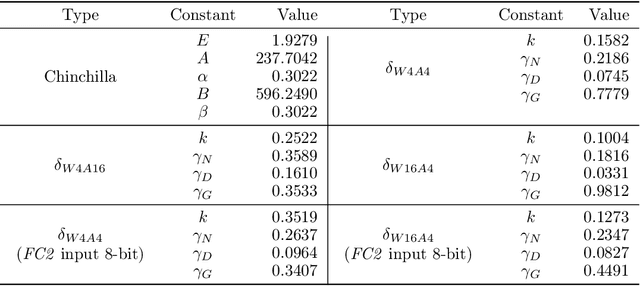
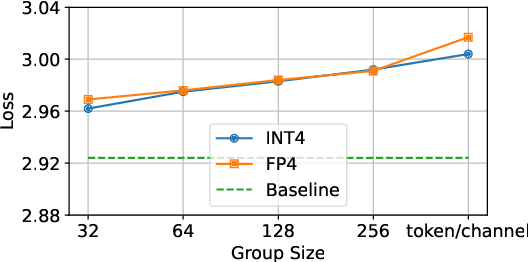

Abstract:Large language models (LLMs) demand substantial computational and memory resources, creating deployment challenges. Quantization-aware training (QAT) addresses these challenges by reducing model precision while maintaining performance. However, the scaling behavior of QAT, especially at 4-bit precision (W4A4), is not well understood. Existing QAT scaling laws often ignore key factors such as the number of training tokens and quantization granularity, which limits their applicability. This paper proposes a unified scaling law for QAT that models quantization error as a function of model size, training data volume, and quantization group size. Through 268 QAT experiments, we show that quantization error decreases as model size increases, but rises with more training tokens and coarser quantization granularity. To identify the sources of W4A4 quantization error, we decompose it into weight and activation components. Both components follow the overall trend of W4A4 quantization error, but with different sensitivities. Specifically, weight quantization error increases more rapidly with more training tokens. Further analysis shows that the activation quantization error in the FC2 layer, caused by outliers, is the primary bottleneck of W4A4 QAT quantization error. By applying mixed-precision quantization to address this bottleneck, we demonstrate that weight and activation quantization errors can converge to similar levels. Additionally, with more training data, weight quantization error eventually exceeds activation quantization error, suggesting that reducing weight quantization error is also important in such scenarios. These findings offer key insights for improving QAT research and development.
Model Merging in Pre-training of Large Language Models
May 17, 2025Abstract:Model merging has emerged as a promising technique for enhancing large language models, though its application in large-scale pre-training remains relatively unexplored. In this paper, we present a comprehensive investigation of model merging techniques during the pre-training process. Through extensive experiments with both dense and Mixture-of-Experts (MoE) architectures ranging from millions to over 100 billion parameters, we demonstrate that merging checkpoints trained with constant learning rates not only achieves significant performance improvements but also enables accurate prediction of annealing behavior. These improvements lead to both more efficient model development and significantly lower training costs. Our detailed ablation studies on merging strategies and hyperparameters provide new insights into the underlying mechanisms while uncovering novel applications. Through comprehensive experimental analysis, we offer the open-source community practical pre-training guidelines for effective model merging.
Group Reasoning Emission Estimation Networks
Feb 08, 2025Abstract:Accurate greenhouse gas (GHG) emission reporting is critical for governments, businesses, and investors. However, adoption remains limited particularly among small and medium enterprises due to high implementation costs, fragmented emission factor databases, and a lack of robust sector classification methods. To address these challenges, we introduce Group Reasoning Emission Estimation Networks (GREEN), an AI-driven carbon accounting framework that standardizes enterprise-level emission estimation, constructs a large-scale benchmark dataset, and leverages a novel reasoning approach with large language models (LLMs). Specifically, we compile textual descriptions for 20,850 companies with validated North American Industry Classification System (NAICS) labels and align these with an economic model of carbon intensity factors. By reframing sector classification as an information retrieval task, we fine-tune Sentence-BERT models using a contrastive learning loss. To overcome the limitations of single-stage models in handling thousands of hierarchical categories, we propose a Group Reasoning method that ensembles LLM classifiers based on the natural NAICS ontology, decomposing the task into multiple sub-classification steps. We theoretically prove that this approach reduces classification uncertainty and computational complexity. Experiments on 1,114 NAICS categories yield state-of-the-art performance (83.68% Top-1, 91.47% Top-10 accuracy), and case studies on 20 companies report a mean absolute percentage error (MAPE) of 45.88%. The project is available at: https://huggingface.co/datasets/Yvnminc/ExioNAICS.
mR$^2$AG: Multimodal Retrieval-Reflection-Augmented Generation for Knowledge-Based VQA
Nov 22, 2024



Abstract:Advanced Multimodal Large Language Models (MLLMs) struggle with recent Knowledge-based VQA tasks, such as INFOSEEK and Encyclopedic-VQA, due to their limited and frozen knowledge scope, often leading to ambiguous and inaccurate responses. Thus, multimodal Retrieval-Augmented Generation (mRAG) is naturally introduced to provide MLLMs with comprehensive and up-to-date knowledge, effectively expanding the knowledge scope. However, current mRAG methods have inherent drawbacks, including: 1) Performing retrieval even when external knowledge is not needed. 2) Lacking of identification of evidence that supports the query. 3) Increasing model complexity due to additional information filtering modules or rules. To address these shortcomings, we propose a novel generalized framework called \textbf{m}ultimodal \textbf{R}etrieval-\textbf{R}eflection-\textbf{A}ugmented \textbf{G}eneration (mR$^2$AG), which achieves adaptive retrieval and useful information localization to enable answers through two easy-to-implement reflection operations, preventing high model complexity. In mR$^2$AG, Retrieval-Reflection is designed to distinguish different user queries and avoids redundant retrieval calls, and Relevance-Reflection is introduced to guide the MLLM in locating beneficial evidence of the retrieved content and generating answers accordingly. In addition, mR$^2$AG can be integrated into any well-trained MLLM with efficient fine-tuning on the proposed mR$^2$AG Instruction-Tuning dataset (mR$^2$AG-IT). mR$^2$AG significantly outperforms state-of-the-art MLLMs (e.g., GPT-4v/o) and RAG-based MLLMs on INFOSEEK and Encyclopedic-VQA, while maintaining the exceptional capabilities of base MLLMs across a wide range of Visual-dependent tasks.
Best Practices for Distilling Large Language Models into BERT for Web Search Ranking
Nov 07, 2024Abstract:Recent studies have highlighted the significant potential of Large Language Models (LLMs) as zero-shot relevance rankers. These methods predominantly utilize prompt learning to assess the relevance between queries and documents by generating a ranked list of potential documents. Despite their promise, the substantial costs associated with LLMs pose a significant challenge for their direct implementation in commercial search systems. To overcome this barrier and fully exploit the capabilities of LLMs for text ranking, we explore techniques to transfer the ranking expertise of LLMs to a more compact model similar to BERT, using a ranking loss to enable the deployment of less resource-intensive models. Specifically, we enhance the training of LLMs through Continued Pre-Training, taking the query as input and the clicked title and summary as output. We then proceed with supervised fine-tuning of the LLM using a rank loss, assigning the final token as a representative of the entire sentence. Given the inherent characteristics of autoregressive language models, only the final token </s> can encapsulate all preceding tokens. Additionally, we introduce a hybrid point-wise and margin MSE loss to transfer the ranking knowledge from LLMs to smaller models like BERT. This method creates a viable solution for environments with strict resource constraints. Both offline and online evaluations have confirmed the efficacy of our approach, and our model has been successfully integrated into a commercial web search engine as of February 2024.
On Convergence and Rate of Convergence of Policy Improvement Algorithms
Jun 16, 2024Abstract:In this paper, we provide a simple proof from scratch for the convergence of the Policy Improvement Algorithm(PIA) for a continuous time entropy-regularized stochastic control problem. Such convergence has been established by Huang-Wang-Zhou(2023) by using sophisticated PDE estimates for the iterative PDEs involved in the PIA. Our approach builds on some Feynman-Kac type probabilistic representation formulae for solutions of PDEs and their derivatives. Moreover, in the infinite horizon model with a large discount factor and in the finite horizon model, we obtain the exponential rate of convergence with similar arguments.
 Add to Chrome
Add to Chrome Add to Firefox
Add to Firefox Add to Edge
Add to Edge